Bamboo is a Grass…
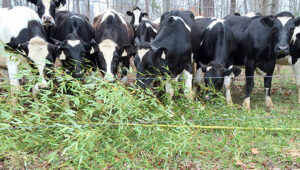
A farmer who plants bamboo waits eight years to harvest shoots in marketable size and quantity. A farmer planting pecan trees waits seven years for his first harvest of nuts — or he waits longer depending on the variety of pecan and the level of management.
During the eight years that the bamboo requires to grow large, the grove adds new and larger canes each spring. Older, smaller canes need to be thinned. I like to thin in June each just after shooting is complete because I want the new, larger canes to have ample light for their leaves and branches. However, often I don’t get the thinning done and end up thinning year around by hauling poles daily to my steers.
These poles make excellent mulch when chipped. I use the chips in my dog yard, on my gardens and in my groves.
I plan to make bagged feed from bamboo leaves, branches and poles. David Harvey of Timber Bamboo Nursery makes pelletized bamboo fodder for his chickens. He gave me some pellets, fibers and chips. I gave a few handfuls of bamboo pellets to my steer Big Boy at the American Bamboo Society Conference. He ate them right up. He also ate the bamboo fibers and the raw bamboo (pole, branches, leaves) shredded by David’s chipper.
I sent the pellets via my extension agent to be analyzed. Will post results when I get them. I believe that bagged bamboo feed would have excellent quality and healthy levels of protein and fiber. Big Boy showed that they taste great.
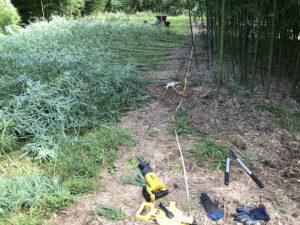 Photo with loppers and reciprocating saw shows fresh cut poles lined up at the edge of my 6 year old vivax grove.
Photo with loppers and reciprocating saw shows fresh cut poles lined up at the edge of my 6 year old vivax grove.
We cut all the canes that were outside the line of irrigation heads. We added them to our pile of poles.
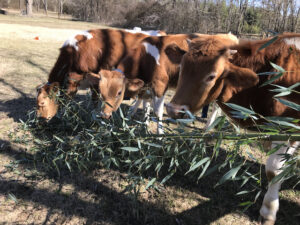 With twelve research plots, each having four sides with canes outside the irrigation heads, our pile was large.
With twelve research plots, each having four sides with canes outside the irrigation heads, our pile was large.
I have three guernsey calves. Each morning I cut bamboo poles and take them to the calves. I spread them in the corral. While they eat the leaves in the corral, I clean the shed and get ready for them to come in for breakfast. Photo shows poles whose leaves were eaten and fresh ones not yet eaten.
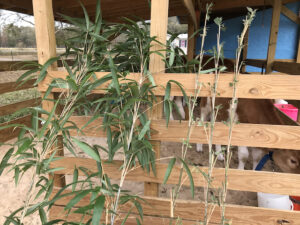
Farmers with more cattle than I have can make a rack to hold the canes so the cattle can pull the leaves as they bite. Or just throw the poles over the fence and let the cattle stand on the canes and pull at the leaves. Entertainment!
Livestock will eat bamboo hay. To make bamboo hay, dry the branched tops in the sun for a day or two. Store them on racks under a roof and out of the rain. Bamboo hay will be dry in a week or sooner depending on humidity.
I use dried bamboo leaves to make bamboo iced tea.
Cattle will eat any bamboo. Serve them whatever variety you have already growing. By cutting a few poles each day, you gradually get important thinning done.
However, if you are planting bamboos just for feeding cattle, here are some thoughts. Plant dwarf bamboos outside the pasture fence. As they mature, they will grow as a weed free thick ground cover. Let them run into the pasture. Cattle will roam the perimeter fence and chow down on the dwarfs that shoot up in the pasture. They will also reach over the fence and damage it. You need a hot wire to protect the fence.
Plant bamboos to harvest canes from outside the pasture. Plant bamboos with big leaves, short branches, and canes under 1 inch. I have been feeding Pseudosasa amabilis. I chose to harvest from it because it is adjacent to my pasture. I only recently appreciated that its leaves are large, dark green and blemish free. Because the branches are very short, the poles are easy to stack. Mine is a young grove so in later years, I will have 2 inch diameter poles, not as easy to cut as the less than an inch ones now in the grove. At that time, I will save the bottom, branch free pole and feed the branched tops to the cattle.
I thinned two canes in the morning and two canes at night for the last several months from my Amabilis grove. I stopped thinning this grove because if I remove more canes I will reduce its ability to shoot abundantly next spring.
I switched to cutting from a six year old Phyllostachys meyeri grove. The leaves are small. The leaves are spotted with damage from insects and mold. The branches are long. The cattle don’t care. They eat them anyway one little leaf at a time. But when I go to pile the poles, they do not lie neatly like the amabilis. The branches are long and springy. The pile is now messy. I have some Phyllostachys with clean leaves this time of year, but most have either insect damage or fungus damage or both.
I have three recommendations for choosing a bamboo specifically for feeding cattle.
First, use the bamboo you alreadyhave. Thin out the dead and leaning poles and all that look weak and crowded. Cattle will happily eat your rejects. Fertilize and water your existing bamboo. Mulch it well.
Second, If planting specifically to feed cattle, choose bamboos with big, healthy, dark green leaves, short branches and canes that are easy to cut with loppers. Consider Pseudosasa japonica, Pseudosasa amabilis, Semiarundinaria fastuosa, Arundinaria gigantea and, no doubt, others.
Third, consider the animals’ need for shade and a windbreak. In the center of their pasture, fence off a doughnut hole. Plant a bamboo in the fenced off center, thick enough to break the wind, tall enough to cast shade, and with great foliage for eating. The cattle can move to the shaded side as the day wears on. Cattle will stress the fence reaching in to bite the leaves, build with that in mind.
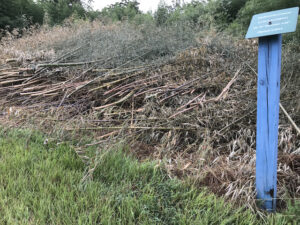 Your maturing groves will generate large piles of thinned poles. At my farm, we rent a chipper twice a year. I use the chips for mulch within the groves and to cover the dog yard. I also use the mulch near small bamboos to draw the rhizomes and expand the grove quickly. The chipped poles are an additional product that can be sold.
Your maturing groves will generate large piles of thinned poles. At my farm, we rent a chipper twice a year. I use the chips for mulch within the groves and to cover the dog yard. I also use the mulch near small bamboos to draw the rhizomes and expand the grove quickly. The chipped poles are an additional product that can be sold.
Run the thinned poles through a 6 or 12 inch chipper. Sell the chips. Use the chips for bedding. Use them to to mulch your groves and cover pot holes in dirt roads. Bamboo mulch is great in dog yards because the shreds of bamboo bind together. When dogs run, bamboo mulch scatters less than wood chips. It stays in place better.
Photo shows Guernsey calves climbing on a pile of bamboo chips.
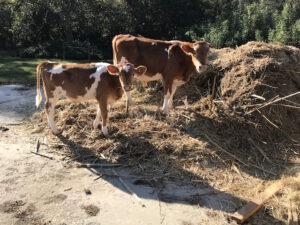 I posted emails from various bamboo experts below. These were written during the days of Yahoo Groups, before Facebook was available. Experts are from India, Australia and US. Read them and be content to feed bamboo to your livestock.
I posted emails from various bamboo experts below. These were written during the days of Yahoo Groups, before Facebook was available. Experts are from India, Australia and US. Read them and be content to feed bamboo to your livestock.
Email from the Bamboo Plantations Yahoo! Group
Re: Bamboo as forage
Date: October 31, 2009 6:57:37 AM PDT
Hello, I have no idea about how to commercially exploit Bamboo leaves for forage,
but I do know that cattle love to eat the leaves…it’s something that almost ruined
me. I’d put up a stone soil wall around my plantation and the cattle would jump and
get in…the villagers were not in a habit of tying up their stock. I believe Bamboo
leaves are something of a delicacy for cattle…they prefer it to other foliage. My
only consolation is that the cattle will not be able to
reach the leaves once the bamboo gains height.
Regards, Amit ChopraEmail from the Bamboo Plantations Yahoo! Group
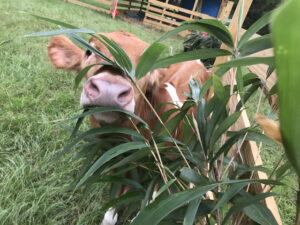 Re: Bamboo as forage
October 30 2009.
Hi Bruce, I used to be part of a bamboo planting effort in Washington State.
My friend Simon Henderson would pick up a fresh bamboo pole with
branches and leaves. He would run along the pasture fence and the
big black beef cow would run after him with drool coming out of
her mouth. Then Simon would give her the pole. Simon also gave
bamboo to the llamas on the land.
Re: Bamboo as forage
October 30 2009.
Hi Bruce, I used to be part of a bamboo planting effort in Washington State.
My friend Simon Henderson would pick up a fresh bamboo pole with
branches and leaves. He would run along the pasture fence and the
big black beef cow would run after him with drool coming out of
her mouth. Then Simon would give her the pole. Simon also gave
bamboo to the llamas on the land.
Horses, elephants, sheep
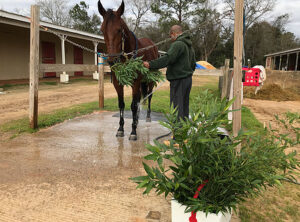 Once I had a job thinning a hedge of Semiarundinaria fastuosa. In the back pasture were horses. We took a few poles with leaves that we thinned to the horses. I remember being amazed. The horse somehow pulled the culm WAY up into its long neck and head and when the pole came back out, all the leaves were stripped off.
Once I had a job thinning a hedge of Semiarundinaria fastuosa. In the back pasture were horses. We took a few poles with leaves that we thinned to the horses. I remember being amazed. The horse somehow pulled the culm WAY up into its long neck and head and when the pole came back out, all the leaves were stripped off.
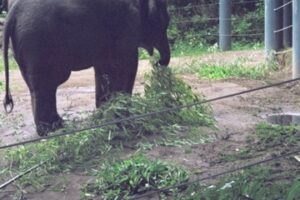 At the WSU research groves over the summer, there were sheep as part of research on managing soil by rotating annual vegetables, cover crops, sheep and chickens. We had work parties to thin the groves. l would take a few nice leafy poles to the sheep. They would run to me when they saw me. Then they settled down to strip the leaves after I heaved them over the two movable electric fences.
At the WSU research groves over the summer, there were sheep as part of research on managing soil by rotating annual vegetables, cover crops, sheep and chickens. We had work parties to thin the groves. l would take a few nice leafy poles to the sheep. They would run to me when they saw me. Then they settled down to strip the leaves after I heaved them over the two movable electric fences.
As for cows needing the branches cut. Garold Nelson used to cut several poles each day and tie them to his fence. When the cows and steers were finished stripping the leaves and twigs, trimming the poles for preparation, storage and sale was easier.
Daphne Lewis
Laboratory Reports
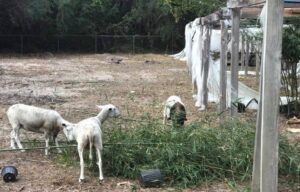
Sheep in Florida enjoying fresh cut bamboo poles
Having analysed many bamboo samples during my time as a plant and soil chemist, I can give you the ball park range. Bamboo leaves contain roughly 1-3 percent nitrogen by dry weight. This is equivalent to around 6-19 percent protein. That compares quite well with other stock feed grasses. In Australia, bamboo growers fertilise to achieve 3 percent foliar nitrogen. Protein testing must be done in a laboratory, because the leaf sample must be completely digested in strong acid to release all the nitrogen for measurement. The test is called “Kjeldahl Nitrogen”. In Australia, state government Departments of Industry can perform this test for a reasonable fee and fertiliser companies will often do it for free – and include a recommendation on how to improve the result by using their products. Pax vobiscum … Geoff Kyle.
The simple experiment conducted shows that the inclusion of bamboo in the daily feeding of the chickens results in increase weight gain of the birds, by as much as 70%. This seems to be caused by lengthening of the intestine and possibly enables the birds to gain weight by better absorption of nutrients from the food ingested.
In conclusion, the use of bamboo leaves as regular food for chicken is profitable because it increases the weight gain of the birds. This will redound to better Return on investment (ROI) in the food production.
While the facts gathered in this study show the marked increase in weight of chickens, more studies should be done along these lines:
- Determine the optimal amount of bamboo material given as fodder
- Analysis of nutritional value of other local bamboo species
- Analysis of nutritive content of chicken fed with bamboo leaves
- The effects of feeding other animals with bamboo leaves
Bamboo Leaves as Chicken Feed and Fodder, Carmelita B. Bersalona
In-Hand Abra Foundation Inc., Philippines